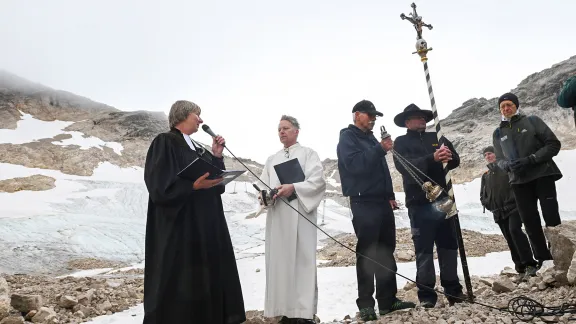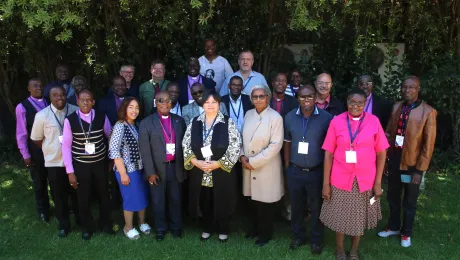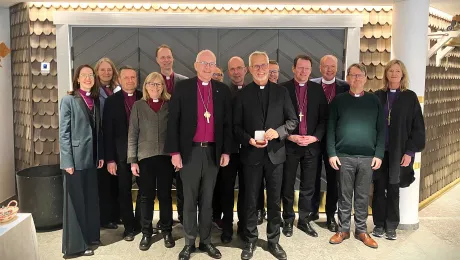With an ecumenical ceremony at the top of Germany’s highest mountain peak, churches drew attention to the effects of climate change. The requiem for a dying glacier marked the rapid disappearance of the ice caps of the Alps.

With an ecumenical requiem for the Zugspitze glacier, Bavarian churches drew attention to the effects of climate change. The dwindling glacier was blessed in a church ritual. From left, Lutheran Pastor Ulrike Wilhelm and Catholic Pastoral Assistant Florian Hammerl. Photo: epd-bild/Angelika Warmuth
“The Zugspitze is only a small indicator of the global crisis”
At 2,962 meters, the Zugspitze is Germany’s highest peak and the location of two of Germany’s four remaining glaciers. To draw attention to the consequences of rapidly advancing climate change and the importance of creation care, clergy from the Evangelical Lutheran Church in Bavaria and the Archdiocese of Munich and Freising organized an ecumenical requiem for the Northern Schneeferner.
With a “prayer for the dwindling Schneeferner, the whole of nature and the future of living environments” on 25 July in the popular tourist area of the Alps, Rev. Ulrike Wilhelm and Pastoral Assistant Florian Hammerl wanted to raise awareness about the climate crisis. The event’s theme was taken from Psalm 121: “I lift up my eyes to the hills - from where will my help come?” It featured information on climate change, a ceremony and space to mourn the “dying” glacier, and the call to tackle climate change together.
According to scientists, the Northern Schneeferner will probably lose its status as a glacier by 2030. Its ice lost nearly a third of its thickness from 2014 to 2022. At that time, the ice was still 39 meters at its thickest point; last year, it had dwindled to 27 meters. According to the World Meteorological Organization, the Swiss Alps also saw a third of its glacier volume disappear between 2001 and 2022.
The climate crisis becomes a pastoral problem
“I see the glacier here becoming ever smaller,” said pastor Wilhelm. “And I see upset people: People who were here 20 or 30 years ago and now come back are often quite shocked.” Wilhelm says she has many conversations and notices “that these climate changes are increasingly becoming a pastoral problem – they stir up deep fears within us.”
She said many people living at the foot of the Zugspitze are also shocked. On top of “their” mountain, there is only debris and rocks instead of snow and ice.
Back in her school days, Barbara from Grainau, a town in the valley below, had learned: “The glacier on the Zugspitze has eternal ice!” She attended the memorial service with her sister Ingrid. The fact that the “eternal ice” would soon be gone worried her a lot, she said.
To bless the dying glacier, church musician Wilko Ossoba-Lochner composed an “Elegy to the End of the Eternal Ice” performed during the requiem. The slow and lamenting rhythm of a bombo drum accompanied the dissonant sound of three singers quoting Psalm 81: “O that my people would listen to me!”
Despite all the sorrow and inevitability, the theologians also wanted to inspire hope at the unusual requiem. Pastoral Assistant Hammerl called for joint efforts to tackle climate change. “Up here, sand is being blown in from the Sahara, ash from the burning jungle in Brazil, soot and dust from the cities, in short: the dirt of the whole world.” The glacier, people, climate, plants, animals – “we all belong and are connected,” Hammerl said.
Scientist welcomes church initiative
“Any occasion is good to bring the issue of climate change closer to people and show them: Something is definitely changing!” said geophysicist Dr. Till Rehm, who coordinates work at the research station on the Zugspitze. “Maybe you’re more likely to reach certain people if you clearly show them the consequences of global warming with such an event. And maybe more conservative people will be reached particularly by the pastoral aspect.”
The real problems concerning melting glaciers are happening elsewhere in the world, South America, and the Himalayas.
– Dr. Till Rehm, geophysicist
Rehm noted, “The fact that the glacier is disappearing here is not all that significant at this stage. Maybe the tourist industry and the ski area have a problem with it because they lose the ‘glacier’ title.”
He explained that “as far as the water supply in the valley and the stability of the mountain are concerned, the glacier became far too small a long time ago.” “The real problems concerning melting glaciers are happening elsewhere in the world, South America, and the Himalayas. There, agriculture will become impossible due to lack of water; there, people will die of thirst because no more water will come from the mountains. What is happening here with us on the Zugspitze are only small indications of the crises coming to people elsewhere,” Rehm added.
Source: epd


